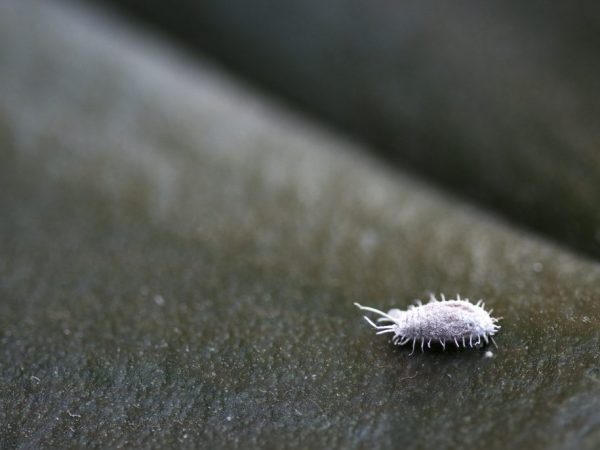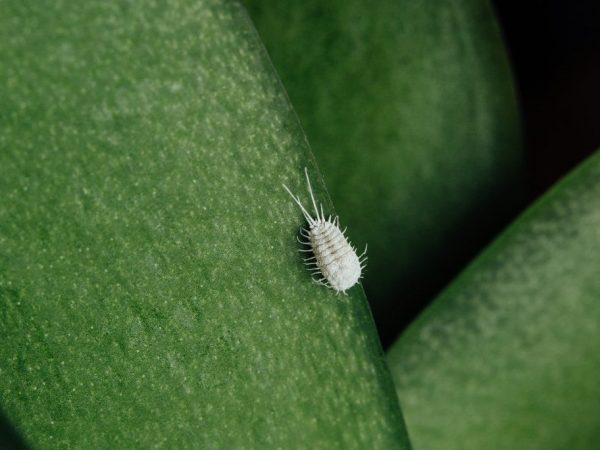How to get rid of white bugs on an orchid
Small white bugs that appear on an orchid are a common problem that almost all flower lovers face. The defeat of mealybugs (often called hairy lice) without the necessary treatment leads to a gradual deterioration in the growth and wilting of the plant, so it is worth starting the fight against them as much earlier.

Fighting white bugs on an orchid
Parasite characteristics
Due to the characteristic appearance of the pest, it is easy to recognize its presence. On the leaves, the parasites look like fluffy white lumps of oval shape, 4-5 cm long. The fluffiness of the bugs is explained by the fact that the female worm secrete a wax mass similar to cotton wool. Under the upper shell, in addition to the insect itself, there is a clutch of yellowish eggs.
Most often, females with fringes around the body and a small tail become the real threat. Male thin winged individuals are rarely found on orchids.
Shaggy lice are located in most cases on the stem and leaf part of the flower. In places where pests settle, a white waxy coating and sooty fungi in the form of black dots appear, which are grown on the sugary secretions of furry lice.
Causes and signs of infection
Parasites can appear on the orchid due to such violations in the care:
- low room temperature;
- excess moisture in the air;
- increased substrate moisture;
- uncleaned plant debris (sluggish stems, dry leaves, fallen buds);
- excess of mineral fertilizers.
Another reason for the defeat of an orchid is the use of contaminated soil that has not undergone disinfection. Neighborhood with a recently purchased and not quarantined plant also increases the chances of infection with a small pest.
The insects are quite unpretentious and feel comfortable on all types of orchids - Phalaenopsis, Wanda, Cattleya, Dendrobium, Aganizia, etc. Plants affected by bugs stand out for their painful appearance:
- deformation and death of leaves;
- yellowing of foliage and trunk;
- stopping growth;
- the presence of small white lumps on the surface of the stems and leaves.
Weakened flowers are at risk, especially in winter. This is facilitated by the violation of metabolic processes, a reduction in the length of daylight hours, drying out of the air due to the use of batteries.
Danger of defeat
The harmfulness of these beetles is extensive and covers the following types of dangers:
- The nutrition of parasites with plant juices causes a deficiency of nutrients in the flower itself, which leads to a cessation of natural growth and development.
- Production of a special sticky nectar (honeydew) that remains on the stem and leaves of the plant. The sweet substance attracts many types of insect pests and serves as a catalyst for the development of mold, which causes oxygen starvation of the flower.
- Beetles can settle not only on the visible parts of the plant, but also in the roots (most often this happens when contaminated soil is added to the pot). In such conditions, insects can be detected only after a long time, when the orchid will be significantly damaged and it will be problematic to fight the defeat. Roots in the ground will continue to rot, and the pest population will spread to the entire flower and all nearby plants.
Mealybug control methods

Affected plants need to be isolated
If there are white bugs in the orchid, hygienic precautions are taken:
- the use of rubber gloves when performing the necessary procedures;
- disinfection of instruments in contact with plants, or the use of disposable;
- isolation of affected flowers.
Most of the fluffy pests are formed on young shoots, but the entire orchid is subject to processing. Treat the affected ornamental culture at home effectively with chemicals or folk methods, but first you need to remove all adults.
Mechanical restoration
Mechanical actions will help determine the area of the lesion and prevent its recurrence. First of all, foliage is processed, buds on a diseased plant are best removed.
To get rid of small bugs, you must:
- Wipe the foliage with a cotton ball dipped in soapy water or other special treatment agent.
- Cut off the affected processes by 10 mm and remove the found insects with tweezers.
- Look closely at the roots and soil in the pot. If insects are present in the soil, treat the root system with a special solution and transplant the plant into another soil.
- Phalaenopsis, Wandas, Cattleyas and other species of this flower are whimsical crops, so it is advisable to get rid of parasites in the early stages of infection, until the plant dies.
Insecticide use
Small egg sacs, even after collecting bugs, often remain on the bark, leaves or stem. In the most advanced cases, special chemicals are usually used (Fitoverm, Aktara, etc.).
Before processing, you need to completely collect all visible bugs (it is better to use paper towels, a rag or a brush), sprinkle them with alcohol and crush them.
The waxy protective layer does not allow chemicals to pass through, so conventional spray treatments will not be effective. Only special agents against white mealybugs can dry out the cover of these harmful insects.
In case of significant damage, the most affected areas are removed.
Small bugs can hide in the pot, soil and roots, so it is unlikely that it will be possible to get rid of them from the first treatment. In most cases, 3-5 procedures with a week break will be required for a complete cure. The difficulty lies in the fact that the population is made up of insects of different age groups and only young individuals can be removed from the first treatment. The older the individuals, the harder it is to get rid of them.
Traditional methods
Traditional methods of treatment include the following solutions:
- Oil emulsion. To prepare the product, mix 2 mt. l. olive oil with 1 liter of water and spray the flower.
- Soap-alcohol solution. Consists of 15 g of liquid soap, 10 ml of denatured alcohol per liter of warm water. This product should not be used on thin-leaved orchid varieties. During the first treatment, it is best to use a small amount of medicine to test the effects on the plant.
- Garlic tincture. For 0.5 liters of boiling water, 5-6 finely chopped cloves of garlic are taken. The resulting mixture is infused for 4-5 hours, filtered and applied with a brush or brush.
Prevention of infection
To prevent white bugs from getting in the orchid, you must do the following:
- Inspection of the new flower for the presence of white honeydew, egg clutches and adults.
- Using quality soil for planting.
- Timely collection of all dried leaves, buds and stems.
- Creating favorable conditions for keeping a flower - establishing the correct temperature regime, frequency of watering and fertilization.
The presence of even one small bug is a possible beginning of serious problems for the culture, therefore it is important to periodically conduct a visual inspection of the orchids, especially during the off-season and in winter.
Conclusion
To combat the mealybug, there are special insecticides and proven folk methods. All types of orchids are susceptible to infection by these insects - Phalaenopsis, Wanda, Cattleya, Dendrobium, Aganizia, etc. Treatment methods do not depend on the variety and are most effective at an early stage of the lesion.


